#truncated cube
Explore tagged Tumblr posts
Text

Drawing a truncated cube and a cuboctahedron from a cube....
As for understanding truncation: You can imagine having a cheese cube and just cutting of the vertices...
- - -- --- -----
Truncated cubes and cuboctahedra are Archimedian solids.
----- --- -- - -
I used isometric dot paper.
#math#geometry#math illustration#cube#truncated cube#cuboactahedron#archimedian solid#geometric drawing#isometric#isometric paper#mathematics#math art#polyhedra#polyhedron#shapes#knottys math art#mathy stuffy#mathy stuff#knotty et al
382 notes
·
View notes
Text
Regular-ish Convex Polyhedra Bracket — Round 1


Propaganda
Icosidodecahedron:
Archimedean Solid
Quasiregular
Dual of the Rhombic Triacontahedron
It has 12 regular pentagonal faces, 20 regular trianglar faces, 60 edges, and 30 vertices.
Vertex Transitive AND Edge Transitive
Image Credit: Cyp
Truncated Cube:
Also called the Truncated Hexahedron
Archimedean Solid
Semiregular
Dual of the Triakis Octahedron
It has 6 regular octagonal faces, 8 regular triangular faces, 36 edges, and 24 vertices.
Image Credit: Cyp
6 notes
·
View notes
Text
D&D needs to get hip to the d14
#truncated cube my beloved...#or for the discerning geometrical connoisseur...a truncated octahedron mayhaps?#basically I want more Archimedean solids in fun colours & styles to use in games. Plato has had his turn#rhombicosidodecahedron... last night I dreamt I held u in my arms...#that would be a terrible die shape though can u imagine#just use a marble I reckon#D&D#shapes#'oh but where would u even use a d14 in D&D what's it for-' SHUT. this post is not for u 🫶
5 notes
·
View notes
Text

Zygarde Cube I made in Blender.
11 notes
·
View notes
Text
she's beautiful...
we have a new truncated decachoron.
Make it popular.
And now I present.
THE FACETED TRUNCATED ICOSIDODECAHEDRA

SPREAD IT FARTHER AND WIDER THAN THE TRUNCATED DECACHORON EVER WENT!
GO FORTH MY TROOPS!
#Of course the cube is my one devotion#but still the faceted truncated isosidodecaherdon is beautiful
13K notes
·
View notes
Text
Finally ready to start showing off the project we've been working on for a few weeks.
TRAIN PUZZLE (dot exe) (title pending)

me and @msasterisk are working on a switching puzzle game set on slimegirl astronaut Eaurp Guz's homeworld. You operate an Advanced Steam switcher to move cars around. The prototype implements a single level, a model railroad Inglenook layout, but there will be other original levels as well.
MsAsterisk has done all of the programming and game engine work, I've done the game design and art assets.
more screenshots and development photos below the cut:


Until the last couple of days, the game has used plain colored boxes for its cars. The first playable version, shown here, was just a pixel art train toy, with no actual game mechanics, but with an external list randomizer you could still run the inglenook game.
The physics was apparently a monumental undertaking to get working, but now it works great!

i don't remember what this was about. Truncated the vertices to the unit cube or something.

@thefallencomet's playtesting of the first prototype revealed a severe bug with couplers where switching cars coupled at a distance between three tracks at once would completely break physics. MsAsterisk fixed it by simply breaking couplers when they're too far apart.

car concept art

u.i. concept art. The tracks are bonafide pixel art here, but they've since been replaced with all 3D assets. The loco here is a pixelated render done in blender of the advanced steam tank engine model that i made about a month ago.

control stand model, WIP. We're not sure if we're going to go for this kind of detailed control stand. Why does a steam engine use a control stand that would look more at home on an EMD diesel? It's the magic of Advanced Steam Technology! The actual engine is controlled with actuators and microcontrollers, they're merely operated from the safety of the control cabin. The gauges are for brake cylinder, boiler pressure, steam chest, and speedometer--but no promises about whether these will be functional.



and finally, portraits of the engine crew
More to come as the game continues development.
#Train Puzzle#train#advanced steam#mellanoid slime worldbuilding#shunting#switching#switching puzzle#shunting puzzle#puzzle game#indie game#game dev#video game#train game#steam train#boxcar
121 notes
·
View notes
Text
Found this old drabble I slapped out after hearing the Imagine Dragons song of the same name for the first time. I don't really feel like it's enough for ao3 but I'm fond of it all the same.... maybe someday I'll add on to it. Enjoy a snippet of depressed grieving Ratchet.
▫ ▫ ▫ ▫ ▫ ▫
Wrecked
He doesn't want to move on. Not really.
Doesn't want to forget. Doesn't want this to become normal. Slag it. It's all wrong!
The world tunnels off to somewhere distant, everything but servos moving in a practiced daze blurring beyond his awareness. If he doesn't acknowledge any of it, it will go away. He can work just like this, just like Optimus is just in the other room, just a bridge away, wherever he is. He'll just. Work. Until then. There's always something that needs to be done, even now.
When his processor is tired enough—like it is now, befuddled lag confusing his thoughts, overly error-riddled sectors getting the attention of being partitioned off for temporary shutdown, just to keep him functional—is the best he feels, really. However long it's been since he's recharged—five cycles, ten? He's stopped keeping track, and doesn't have plans to break the streak. It lets him forget everything. Not Optimus—never Optimus—but… reality, or some slag.
Something in his servos snaps, and he curses. Careless, careless. The annoyance is short lived, though, and his frame shudders as he sighs. Okay, welder now. Make up for that mistake. Like all the others. It's fine. He can fix it.
Like he can't fix—
Optics shutter. The thought is truncated—messily, doesn't matter—and shoved aside before he partitions off and reboots a few more sectors. He'll just…
His servos slow and stall as he finishes the repair, welded section set down on the worktable. That done, he lets his helm hang forward for a few moments. A nap might feel nice… it's tempting. Or maybe some energon. His tanks are low, warnings pinging at the edge of his awareness. But it will still be some time before he enters a metabolic shutdown, and the stores are at the other end of the building. He'll be fine for now. Just a little nap.
▫ ▫ ▫ ▫ ▫ ▫
Of course, it is Optimus who comes to hold him in his dream.
The smallest touch feels so wonderful. His spark shudders with relief, exhaustion, love…
“Optimus…” he murmurs. Yes, this… all is right.
Like all good things, though, it ends. Optimus slips away, that same slagging beautiful smile, that awful sadness and regret in his optics. Ratchet whimpers in his sleep—a tiny, pathetic sound, scarcely audible more than a step or two away.
But then, at least, everything is blissfully dreamless. He only wishes he could spend all of his life that way. This is all too short. Time spirals and soon he has to be conscious of the real world again.
He makes a half-sparked grumble, optics blinking open. There's—several parts of his processor fixate immediately—there's… a cube on his desk. He stares at it, not beginning to comprehend how it could possibly have gotten there. It's just sitting there, in a clear space among his tools, heat signature identifying it as slightly warm. He could… drink it. As nice of a distraction as hunger provides, some energon would taste so good.
His servos have already reached it on autopilot and brought it to his intake by the time he finishes the thought. He should at least have a little… yes. He gives up on fighting it and tips it back.
It is warm. A little sweet, with just a hint of a richer note that his chemoreceptors belatedly identify as cadmium.
His hydraulics tighten, stuttering vents making his plating tremble. This kind of thoughtful thing… he knows who, normally, would have done it.
It wasn't. One of the other bots must be visiting, and have taken pity on him. That's kind enough. But he doesn't need it. He's fine.
His servos lower, shaking as they return the cube to the worktable despite the protests of his tanks. He can't… It's just a cube. This is pathetic. He raises it again and drinks, wrestling to control his field as the tension in his frame melts from the warmth. It tastes so good.
Only when the cube is empty does he set it down again and stare blankly at his work. Fuel to get things done… better start again.
47 notes
·
View notes
Text
Polyhedron of the Day #244: Antitruncated cube

The antitruncated cube is a semi-uniform polyhedron. It has 14 faces (8 triangles, 6 tetrapods), 36 edges, and 24 vertices. It is also known as the inflected truncated cube. It is an antitruncation of the cube as well as a faceting of the small rhombicuboctahedron. Its vertex figure is an isosceles triangle. Its dual is the antiapiculated octahedron.
Image created using Robert Webb's Stella software, found at https://www.software3d.com/Stella.php.
18 notes
·
View notes
Text


Cube Compound: I used to put diminished cubes on the triangle sides of a truncated tetrahedron. This is the first shape I've finished with a cube base shape, and the first time I've tried painting something like it was fluorite.
6 notes
·
View notes
Text
hey so i wanted to program a physics engine thing that uses unit cubes and stuff
and i was like "i might need a special grid" so i decided to use truncated octohedrons instead
and I found this thing on it's wikipedia page about Brillouin zones
and it says it's used in solid state physics and also math and it's 2d thing is a hexagon
and i'm like "that matches what i'm thinking about so far" so i gotta know, is what i'm thinking about basically a brillouin zone:
so: given that no two blocks overlap in so many blocks, but can be moved (not rotated), they can be mapped to a grid with units the same size as the block, without repeating any grid positions. but if you extend this to include rotations, the best would probably be a hexagonal tiling or a truncated octohedric tiling. is this basically what that is
4 notes
·
View notes
Text
Polyhedra on dotted isometric paper
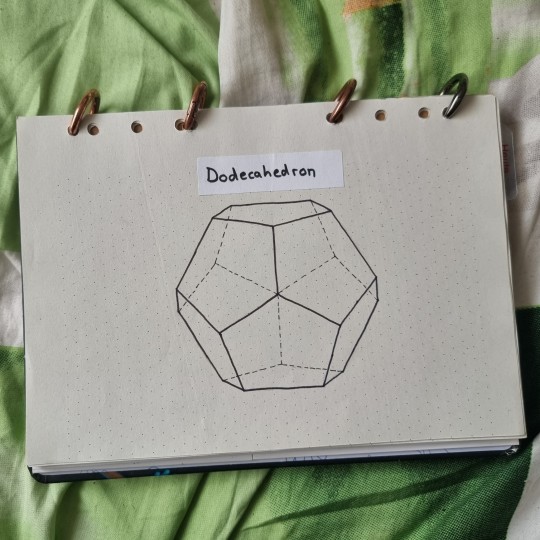
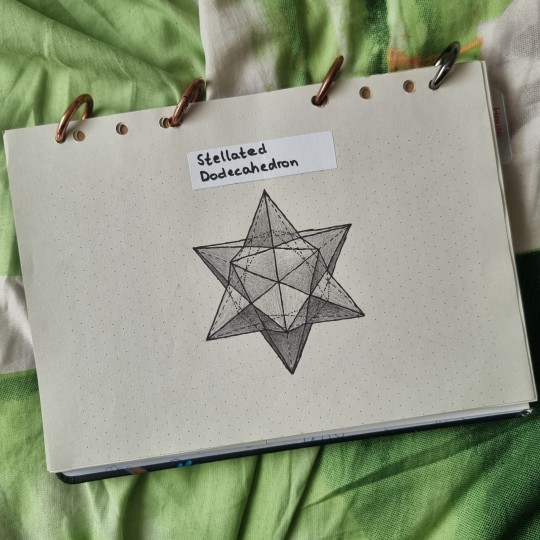
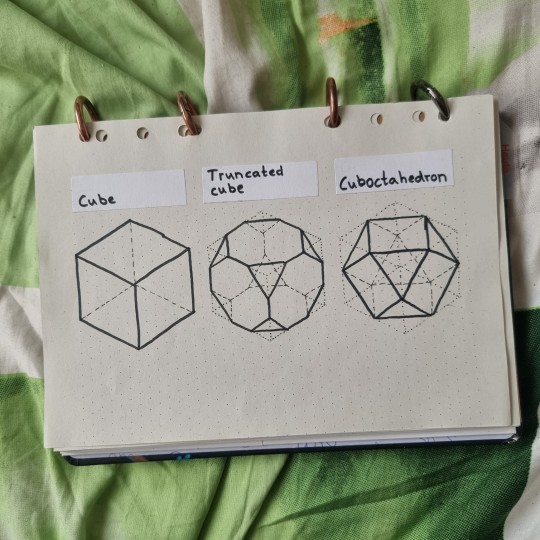
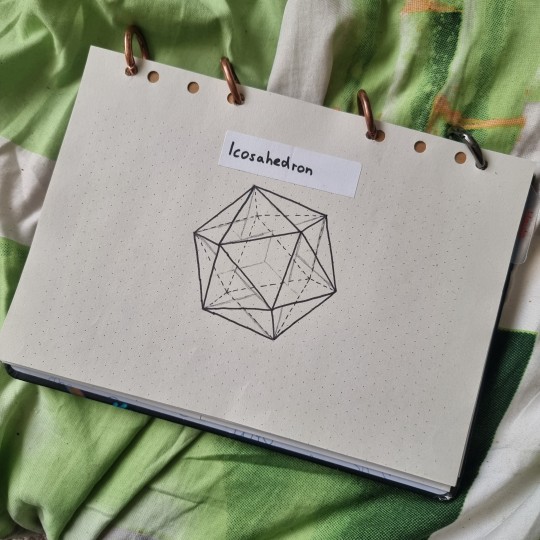
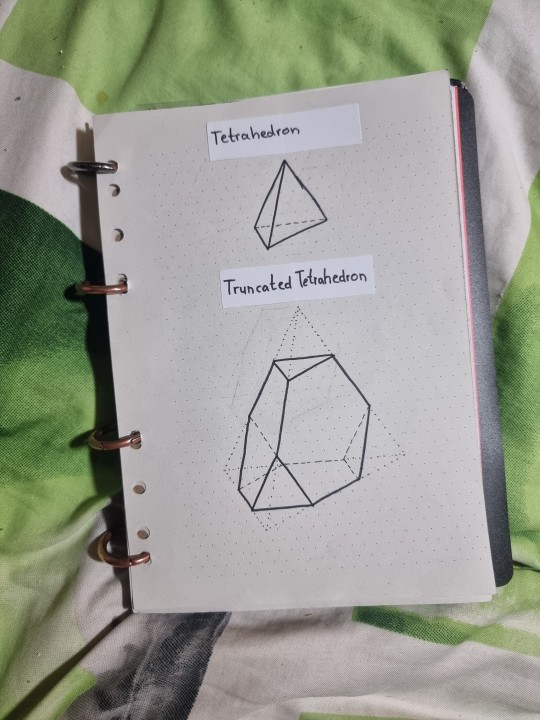
Drawing polyhedra on dotted isometric paper is so calming. One does not need to use a ruler or a compass. Instead one can just count dots to determine the length, and play around with the angles.
#geometry#isometric grid#isometric paper#isometric dot paper#isometric#dodecahedron#stellated dodecahedron#cube#truncated cube#cuboctahedron#icosahedron#mathy art#polyhedron#polyhedra#platonic solids#polyhedra compounds#compounded polyhedra#archimedian solids#archimedian solid#3d#drawing#perspective#polyhedra in perspective#perspective drawing#shapes#forms#calming#illustration#knottys art#math art
139 notes
·
View notes
Text
Regular-ish Convex Polyhedra Bracket — Round 3



Propaganda
Cube:
Also called the Regular Hexahedron
Platonic Solid
Regular
Dual of the Regular Octahedron
It has 6 square faces, 12 edges, and 8 vertices.
Oh, cmon! The cube is great! It tiles space, its one of the platonic solids that has analouges in all dimensionalities, its vertices are can be mapped to the strings of three binary digits in a structurepreserving way, and its literally the most iconic shape of all time!
Image Credit: Tumblr
Rhombicuboctahedron:
Also called the Small Rhombicuboctahedron
Archimedean Solid
Semiregular
Dual of the Deltoidal Icositetrahedron
It has 18 square faces, 8 regular triangular faces, 48 edges, and 24 vertices.
Image Credit: @anonymous-leemur
Truncated Icosidodecahedron:
Also called the Rhombitruncated Icosidodecahedron, Great Rhombicosidodecahedron, Omnitruncated Dodecahedron, Omnituncated Icosahedron
Archimedean Solid
Semiregular
Dual of the Disdyakis Triacontahedron
It has 12 regular decagonal faces, 20 regular hexagonal faces, 30 square faces, 180 edges, and 120 vertices.
It has the most edges and vertices of all platonic and archimedean solids.
Of the vertex-transitive polyhedra, it fills up the most of the volume of the sphere it fits in (89.80%).
It is not actually the shape you get when you truncate an icosidodecahedron, although it is topologically equivalent.
It is the mod's favorite three-dimensional shape.
Image Credit: @anonymous-leemur
#Round 3#Cube#Rhombicuboctahedron#Truncated Icosidodecahedron#Great Rhombicosidodecahedron#Platonic Solids#Archimedean Solids
50 notes
·
View notes
Text
i hate that its called a cube, girl that is a truncated octahedron know your shapes! you ahve a PHD!!!
4 notes
·
View notes
Text
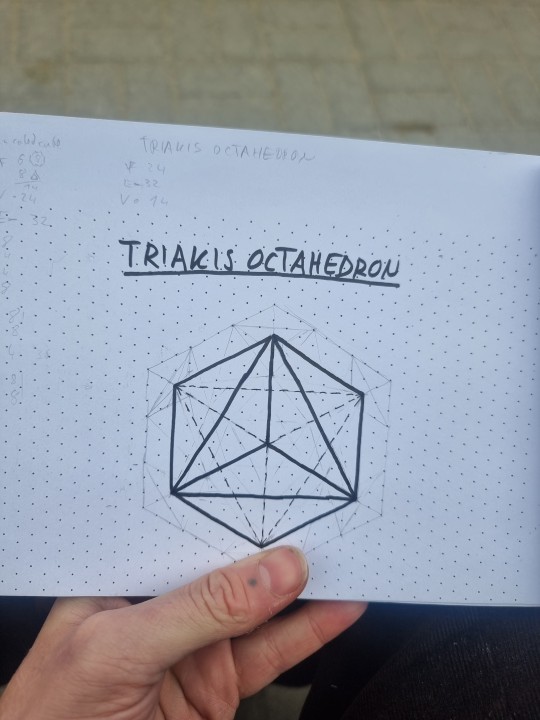
(Saaaadly, the Catalan solids dont look that nice in that isometric projection.
Perhaps their charm would become more present if I put shading into these drawings.)
Today's polyhedron drawing is the Triakis Octahedron, which is the dual of the Archimedean solid called "truncated cube".
A triakis octahedron is like an octahedron with 8 triangular pyramid hats.)
Triakis is greek and meens "trice/three times"
A Triakis octahedron has 32 faces: three times eight (octa) - It has the amount of faces as its name.
Each of the 8 triangular faces of the octahedron has a triangular pyramid hat: each of these pyramids has 3 faces, hence 3*8.
That's why it's called "Triakis octahedron"
#polyhedra#polyhedron#catalan solids#catalan solid#triakis octahedron#geometry#math#mathy#mathematics#geometry enjoyer#shapes#friendshapes#friendshape
13 notes
·
View notes
Text
A Cube, Held Prisoner by a Stella Octangula
I made this three-part compound using Stella 4d (available here) to repeatedly tetstell a truncated octahedron.

View On WordPress
4 notes
·
View notes
